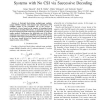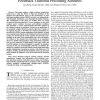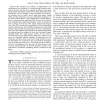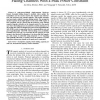98
Voted
ISITA
2010
14 years 10 months ago
2010
Abstract--A Rayleigh block-fading multiple-input multipleoutput (MIMO) channel with channel state information (CSI) available neither to the transmitter nor to the receiver is cons...
122
Voted
VTC
2010
IEEE
14 years 11 months ago
2010
IEEE
—In this paper, we propose a new resource allocation scheme for an OFDMA relay network with multicells. In the proposed scheme, by sharing the channel state information (CSI) bet...
103
Voted
INFOCOM
2010
IEEE
14 years 11 months ago
2010
IEEE
Abstract—Contending flows in multi-hop 802.11 wireless networks compete with two fundamental asymmetries: (i) channel asymmetry, in which one flow has a stronger signal, potent...
146
Voted
CORR
2007
Springer
15 years 16 days ago
2007
Springer
We consider a MIMO fading broadcast channel and compute achievable ergodic rates when channel state information is acquired at the receivers via downlink training and explicit cha...
122
Voted
JSAC
2007
15 years 19 days ago
2007
— Channel state information (CSI) is important for achieving large rates in MIMO channels. However, in timevarying MIMO channels, there is a tradeoff between the time/energy spen...
TSP
2008
15 years 19 days ago
2008
This paper employs a high resolution quantization framework to study the effects of finite-rate feedback of the channel state information (CSI) on the performance of multiple-input
116
Voted
TCOM
2008
15 years 19 days ago
2008
We consider the problem of differentiated rate scheduling for the downlink (i.e., multi-antenna broadcast channel), in the sense that the rates required by different users must sat...
104
click to vote
TCOM
2008
15 years 19 days ago
2008
: Due to correlated fading in frequency hopping (FH) wireless communication systems, it is possible to predict the future channel state information (CSI) for one frequency based on...
CORR
2006
Springer
15 years 23 days ago
2006
Springer
Abstract--A peak-power-limited single-antenna block-stationary Gaussian fading channel is studied, where neither the transmitter nor the receiver knows the channel state informatio...
102
click to vote
CORR
2006
Springer
15 years 23 days ago
2006
Springer
Multiple transmit antennas in a downlink channel can provide tremendous capacity (i.e. multiplexing) gains, even when receivers have only single antennas. However, receiver and tra...




